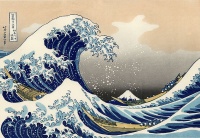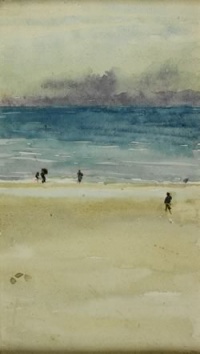Sea
From The Art and Popular Culture Encyclopedia
| Revision as of 14:45, 19 May 2013 Jahsonic (Talk | contribs) ← Previous diff |
Revision as of 07:12, 22 June 2013 Jahsonic (Talk | contribs) Next diff → |
||
| Line 1: | Line 1: | ||
| - | [[Image:The Great Wave off Kanagawa by Hokusai.jpg|thumb|right|200px|''[[The Great Wave off Kanagawa]]'' (between [[1823]]-[[1829|29]], [[woodblock printing in Japan|woodblock printing]] by [[Hokusai]]]][[Image:Sea and Sand, Domburg by Whistler.jpg|thumb|right|200px|''[[Sea]] and [[Sand]], [[Domburg]]'' ([[1900]]) by [[James McNeill Whistler]]]] | + | [[Image:The Great Wave off Kanagawa by Hokusai.jpg|thumb|right|200px|''[[The Great Wave off Kanagawa]]'' (between [[1823]]-[[1829|29]], [[woodblock printing in Japan|woodblock printing]] by [[Hokusai]]]] |
| + | [[Image:Sea and Sand, Domburg by Whistler.jpg|thumb|right|200px|''[[Sea]] and [[Sand]], [[Domburg]]'' ([[1900]]) by [[James McNeill Whistler]]]] | ||
| [[Image:Sonata of the Sea. Finale (1908) by Mikalojus Konstantinas Čiurlionis.jpg|thumb|right|200px| | [[Image:Sonata of the Sea. Finale (1908) by Mikalojus Konstantinas Čiurlionis.jpg|thumb|right|200px| | ||
| ''[[Sonata]] of the [[Sea]]. Finale'' ([[1908]]) by [[Lithuania]]n painter [[Mikalojus Konstantinas Čiurlionis]]s]] | ''[[Sonata]] of the [[Sea]]. Finale'' ([[1908]]) by [[Lithuania]]n painter [[Mikalojus Konstantinas Čiurlionis]]s]] | ||
Revision as of 07:12, 22 June 2013
|
Related e |
|
Featured: |
The sea is the connected body of salt water that covers 70 percent of the Earth's surface. The sea is important in moderating the Earth's climate, in providing food and oxygen, in its enormous diversity of life, and for navigation. The study of the sea is called oceanography. The sea has been travelled and explored since ancient times, but its scientific study dates broadly from the voyages of Captain James Cook to explore the Pacific Ocean between 1768 and 1779.
Seawater is characteristically salty. The main solid in solution is sodium chloride but the water also contains chlorides of potassium and magnesium, alongside many other chemical elements, in a composition that hardly varies across the world's oceans. However the salinity varies quite widely, being lower near the surface and near the mouths of large rivers and higher in the cold depths of the ocean. The sea surface is subject to waves caused by winds. Waves decelerate and increase in height as they approach land and enter shallow water, becoming tall and unstable, and breaking into foam on the shore. Tsunamis are caused by submarine earthquakes or landslides and may be barely noticeable out at sea but can be violently destructive on shore. Winds create currents through friction, setting up slow but stable circulations of water throughout the sea. The directions of the circulation are governed by several factors including the shapes of the continents and the rotation of the earth. Complex deep sea currents known as the global conveyor belt carry cold water from near the poles to every ocean. Large-scale movement of seawater is also caused also by the tide, the twice-daily rhythm of the gravitational pull exerted by the Moon, and to a lesser extent by the Sun, on the Earth. Tides may have a very high range in bays or estuaries such as the Bay of Fundy where tidal flows are funnelled into narrow channels.
All the major groups of living organisms are found in the sea including bacteria, protists, algae, plants, fungi and animals. It is widely regarded to be the place where life first began, as well as where many of the major groups evolved. The sea contains a wide range of habitats and ecosystems, ranging vertically from the sunlit surface waters and the shoreline to the enormous depths and pressures of the cold, dark abyssal zone, and in latitude from the waters under the Arctic ice to the colourful diversity of coral reefs in tropical waters. It provides substantial supplies of food, mainly fish, but also of other animals including whales and of seaweeds to people around the world, both of wild-caught fish and from aquaculture.
Human uses of the sea include trade, food production, leisure activities such as swimming, sailing and scuba diving, mineral extraction, and warfare. Many of these activities also create pollution. The sea is important in human culture, with major appearances in literature since Homer's Odyssey, in marine art, in cinema and theatre, and in classical music. Symbolically, the sea appears as monsters such as Scylla in mythology, and represents the collective unconscious in some forms of psychotherapy.
Derived terms


_by_Mikalojus_Konstantinas_Čiurlionis.jpg)


